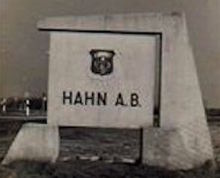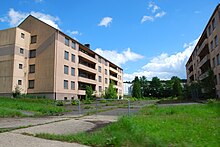Hahn Air Base
The Hahn Air Base was one of the NATO - military airfields , which during the Cold War by the US Air Force were operated in Germany. It was 10 km from Kirchberg , 20 km from Simmern and 2 km from the small town of Hahn in the Hunsrück in Rhineland-Palatinate , Germany . As part of the armaments conversion , Hahn Air Base was expanded into Frankfurt-Hahn International Airport from 1993 .
Emergence
The French occupying forces began building a military airfield in the Hunsrück in 1951, which was taken over by the US Air Force in 1952. From the end of 1954 the base u. a. For almost a year base of a squadron F-86F - fighter-bomber of the 388th Fighter-Bomber Wing , whose intended base Etain was not yet completed.
Base of the 50th Fighter Wing of the United States Air Force
From the end of 1959, Hahn Air Base was the base of the 50th Fighter Wing of the United States Air Force, which was previously located in Toul . It was one of several United States Air Force bases in Germany ( Zweibrücken Air Base , Ramstein Air Base , Sembach Air Base , Bitburg Air Base , Spangdahlem Air Base and Rhein-Main Air Base ), all within a radius of about 100 km from each other. Because of their location in the heart of US troop concentrations, these air bases were well located to reach all locations in Europe and the Mediterranean region.
structure
Hahn Air Base was the seventh largest US air force base in Europe and the second largest in Germany. The Housing Area (residential area of the American military ) consisted of 672 apartments ranging in size from 60 to 155 square meters in 43 buildings. The single soldiers were housed in 25 barracks buildings. There were 22 office buildings, 52 workshops and 51 warehouses on the site.
Aircraft and ammunition were housed in 343 hangars , bunkers and shelters. The soldiers were able to shop in 23 shops, and after duty there were 32 leisure facilities available - including a golf course, two sports halls, a football field, a stadium, tennis courts and a shooting range. 5 school buildings were available for children. The hospital consisted of 4 buildings, including a dental clinic.
Cruise missile missiles
In 1987 the first cruise missile missiles arrived in Germany. These should be stationed in the Pydna missile base . The planned completion date for the Pydna (end of 1986) could not be met. That is why they were initially stationed on the Hahn Air Base site, because there was the possibility of storing nuclear warheads there.
Task of the air base
Hahn was mainly a fighter-bomber base. The 50th Squadron flew the F-100D / F in the first few years and the F-4D / E between October 1966 and June 1982 . At the end of the Cold War , three F-16 flying squadrons were stationed at Hahn Air Base , with a total of 13,000 people and family members. Hahn became the first European F-16 base in December 1981.
After one of these squadrons, the 10th TFS, was used in the second Gulf War in Iraq in 1991 , their planes returned directly to the United States. The US Air Force initiated the abandonment of the site and withdrew the remaining personnel and equipment by 1993.
Civil use
After the end of its military use, the US armed forces handed Hahn Air Base over to civilian administration on September 30, 1993. The state government of Rhineland-Palatinate identified the abandoned airfield as the one that is easiest to convert to civilian use . As part of the conversion, an international airport was planned to relieve Frankfurt am Main airport . The first civil flight from Frankfurt-Hahn Airport , a charter flight to Mallorca , took place on May 22, 1993.
Individual evidence
- ↑ a b BICC report 4: Restructuring the US Military Bases in Germany: Scope, Impacts, and Opportunities . Keith B. Cunningham and Andreas Klemmer (1995), 66
Web links
Coordinates: 49 ° 56 ′ 55.2 ″ N , 7 ° 15 ′ 50 ″ E





